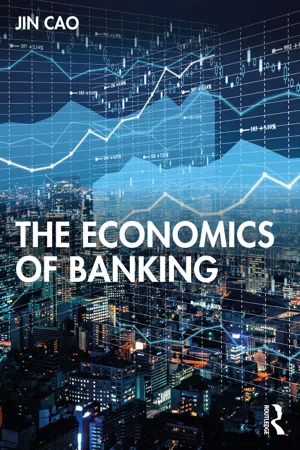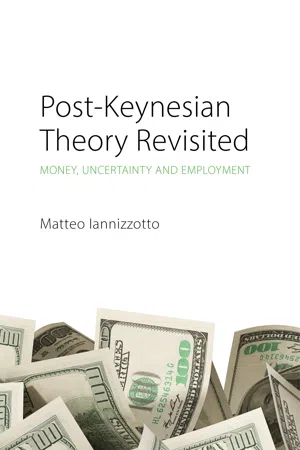Economics
Interbank Deposit
An interbank deposit refers to a financial transaction where one bank places funds with another bank, usually for a specified period and at an agreed-upon interest rate. This arrangement allows banks to manage their liquidity needs and earn interest on excess funds. Interbank deposits are a key component of the money market and play a crucial role in the functioning of the financial system.
Written by Perlego with AI-assistance
Related key terms
3 Key excerpts on "Interbank Deposit"
- eBook - ePub
- Jin Cao(Author)
- 2021(Publication Date)
- Routledge(Publisher)
PART I Introduction CHAPTER 1 Introduction DOI: 10.4324/9780429356773-2 1.1 What Are Banks and Why Are They Special? B anks are among some of the most important yet sometimes the most controversial institutions in an economy. Banks provide socially desirable services for households, firms, and other financial institutions, but bank failure often costs enormously for taxpayers and economic growth. In this chapter, we will take a brief look inside the banking industry, explain terms and jargon that we will use frequently in the rest of this book, and focus on the features in banking that make banks and the economics of banking special. According to Encyclopædia Britannica, a bank is “an institution that deals in money and its substitutes and provides other money-related services. In its role as a financial intermediary, a bank accepts deposits and makes loans”. That is, a bank provides financial intermediation services between lenders and borrowers, collecting funds from lenders and lending the funds to borrowers; of course, nowadays, we shall also interpret “deposits”, “loans”, “depositors”, and “borrowers” more broadly. In addition, the boundary between banks and other types of financial institutions is becoming more and more blurred, for example, certain financial institutions such as mutual funds also provide financial intermediation services. In the narrow sense, only a financial institution that carries a banking license that is issued by banking authority is legally classified as a bank - eBook - ePub
- John Roscoe Turner(Author)
- 2019(Publication Date)
- Routledge(Publisher)
A bank may be likened to a reservoir from which capital (purchasing power) flows in the form of credit. Surplus funds flow into the bank and become the basis of credit issues, which flow out to the places where capital is needed. Thus banks become equalizing agencies of finance throughout the community. Small driblets of idle capital are collected by the banks and consolidated into huge funds capable of meeting the demands for large capital on the part of great industrial establishments. In this way the banks put idle capital to work and they arrange capital in such volumes that it can work most effectively.10. Deposits.Individuals might retain their own funds, might disappoint the burglars by hiding them in unsuspected places, or at enormous expense keep burglar-proof vaults, but a division of labor is better which allows one man to make it his business to provide a place of safekeeping and so do this work for all. Those who intrust their funds to a bank are called depositors and the funds so intrusted are deposits . The bank holds itself ready to pay the depositor at any moment, or "on demand." Individuals would rather leave their means "on deposit" than to bear the risk and inconvenience of carrying them about. Consequently, even the most wealthy carry little money with them; they carry instead the right to draw money. Thus risks and inconvenience are reduced to a minimum.But the money deposited is small in comparison with the deposits made through discounting. A simple illustration will show how deposits are thus made. A merchant who sells on time furnishes a farmer with tools, fertilizer, and seed, taking in exchange his note for $500, which will mature four months hence, when he sells the crop. The merchant cannot exchange this note to distant commercial houses for goods, as such houses would not take the note of a man, though of high moral honor and financial ability, who is unknown except in his home community. But such houses make it a practice to accept the credit of banks. The merchant wishing to use in his business the $500 called for in the note will wish to trade this promissory note to the bank for its generally accepted credit. He indorses this note and presents it to the local banker, who (knowing both the maker and indorser to be honest and able to pay, and knowing further the power of the law to compel payment) is willing to trade the credit of his bank for it. Inasmuch as the note will not mature for four months he will not give in exchange the credit of the bank to the full face value of the note, but accepts the instrument at its present worth ($500 less interest for four months). The merchant is now at liberty to take his pay for the note, for instance, $490, in either of two ways—he may take the cash, or he may leave it with the bank as a deposit and take away a pass-book which evidences the deposit, and a check-book which enables him to draw in such amounts and at such times as he finds convenient. The latter is the usual method followed in this country, therefore in discounting a customer's note the bank increases its own deposits. What does this illustration show a deposit to be? From the standpoint of the bank, a deposit is the bank's promise to pay money to a person or corporation. From the standpoint of the depositor, a deposit is the right to draw upon the bank. - eBook - ePub
Post-Keynesian Theory Revisited
Money, Uncertainty and Employment
- Matteo Iannizzotto(Author)
- 2020(Publication Date)
- Agenda Publishing(Publisher)
2009 : chap. 8) as the end result of a portfolio decision on the part of households, which is the ultimate effect of monetary circulation. As before, banks make loans to firms, and firms use the proceeds to pay households for their labour; it is then that households need to decide how much of their income to retain in the form of bank deposits and how much to demand in securities sold to them by firms. The transactions in securities are here imagined between firms and households, and therefore that portion of the funds does not return to the commercial banking sector in the form of deposits but, rather, in the form of firms repaying the loans extended, the net effect of which is represented by the relative position of the demand for loans schedule. But the crucial point is that the loans-to-deposits line is now the outcome of a portfolio decision on the part of households and not a purely automatic mechanism.The portion of total income allocated to deposits satisfies the transactions demand for money, because, in a modern intermediated economy, payments through cheques and debit cards effectively go through the commercial banking system, with minimal leakages in terms of cash holdings. There will undoubtedly be some transactions that will be performed with cash, but the history of modern capitalist economies is one in which the proportion of such transactions has progressively declined. This is indeed a difference compared with what normal practice would have been like in the days when Keynes was writing, and therefore one that needs to be taken into account when examining the applicability of his theories to the modern world.We are now in a position to analyse what happens in a situation when there is an increase in liquidity preference on the part of households. This will take the form of a reallocation in the portfolio of households, which will now wish to retain a greater proportion of their income in the form of bank deposits, which are liquid, as stated, and buy fewer securities from firms. The effect of such a change in attitude is twofold, as illustrated in Figure 6.4 .Figure 6.4 Increase in liquidity preferenceThe increased demand for bank deposits will be represented in the first instance by a tilting of the loans-to-deposits schedule to the steeper (dashed) one in quadrant III. The effect on the corresponding demand for reserves and the possible reaction of the central bank is here completely ignored so as not to clutter the diagram, but it would be understandable if there were consequently to be an increased demand for reserves. The other effect that does need to be represented, however, is that, with households now buying fewer securities from firms, this necessarily means that the latter have to resort to a greater demand for bank credit, if the planned investments are to take place. This is the reason for a rightward shift in the (dashed) demand for credit schedule in quadrant II
Learn about this page
Index pages curate the most relevant extracts from our library of academic textbooks. They’ve been created using an in-house natural language model (NLM), each adding context and meaning to key research topics.


